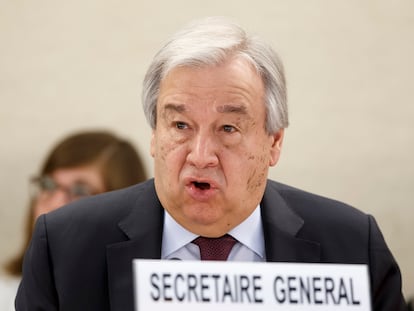Brussels will propose to extend temporary protection for Ukrainian refugees until 2025
The European Commission expects an agreement during the Spanish presidency of the EU, in the second half of the year
The European Commission is taking it for granted that the conflict in Ukraine will keep hundreds of thousands of people on European soil longer than expected. One year after the start of the Russian invasion, Brussels has decided to propose to member states that temporary protection for fleeing Ukrainians be extended until March 2025. Almost four million people are already benefiting from this program, which allows Ukrainian refugees to live and work in the EU.
The proposal to extend the program will be formalized, according to a senior EU source, during Spain’s presidency of the European Council, in the second half of this year.
The initiative involves extending from two to three years the legal status enjoyed by refugees from the war in Ukraine. That special status, made possible by the Temporary Protection Directive, has offered people displaced by the conflict – Ukrainians and citizens of other nationalities living in the country – one year of legal residence and work within EU borders.
This formula was created in 2001, in the context of conflicts in the Balkans that were expected to trigger an influx of people, but it was never used, not even when the war in Syria forced hundreds of thousands of people to leave the country for Europe. But the swift departure of tens of thousands of refugees from Ukraine in the first days of the war led to the activation of the norm.
The temporary protection offers one year of legal residence papers and work permits and contemplates the possibility of an extension for one additional year. According to European sources, this second year is a given and will be announced on March 8. The key was what would happen after that, since the decision to apply a second and final extension depends on the European Council, which must decide on a proposal made by the European Commission.
In Spain, in record time, exiles from Ukraine had documents and tools that other groups take months or years to gain access to
It is not clear if this extension of temporary protection would benefit only Ukrainians or if it would be maintained in general for refugees of other nationalities who have also fled Ukraine. Spanish sources maintain that this point is still under discussion. It is an issue that generated friction when the activation of the EU regulations on international protection was discussed. Not all countries were in favor of granting Ukrainians the same status as citizens of other nationalities who could not return to their home countries.
The norm, in fact, was approved with certain limitations in this regard and only protects nationals of other countries who had a residence permit in Ukraine, leaving out any foreigner in an irregular situation. The agreement left in the hands of each member state the decision to extend its application.
Non-Ukrainian citizens arriving in the EU from Ukraine number around 270,000, the majority being Turkish, Russian and Indian. In Spain, according to official data, non-Ukrainians who have benefited from temporary protection represent under 2% of the 168,500 people who have been granted protection.
The application of the temporary protection directive was key to the swift and unprecedented response that Europe gave to the refugee crisis unleashed by the first bombs to fall on Ukraine. Barely four days after the start of an exodus unseen since World War II, the Commission proposed adopting this formula. And only four days later, the Council approved its implementation. “Historic agreement [...] The European Union is united and in solidarity!” announced the French Minister of the Interior, Gérald Darmanin, on his Twitter account.
Resorting to a specific legal device for such a large influx of people has allowed countries not to further overload their asylum systems, and to recognize basic rights such as health, education or work permits almost automatically in an emergency situation. In Spain, for example, where asylum seekers can spend months waiting for an appointment and years waiting for a decision on their application, a system was applied in which temporary protection and, therefore, residence and work authorizations, are granted in just 24 hours. In record time, exiles from Ukraine had documents and tools that other groups take months or years to gain access to.
The arrival of millions of people, however, has been a challenge in terms of their assimilation by the labor market. It has also sorely tested the welcome network in some countries, although the return of millions of refugees back to Ukraine has gradually eased this pressure. EU sources believe that one of the great pending challenges is the coordination of additional aid, especially in connection with access to housing. The same sources stated, in any case, that the temporary protection program has been a success “despite the difficulties.”
One of the successes, said these sources, is that it allowed the launch of a data collection platform that did not previously exist, and which can be applied in other contexts. With this database, in which all the member states share information, it is possible to know how many people are entering through the EU’s borders, where they are, what status they have and if there are imbalances to help offset them.
The experience of the war in Ukraine will, according to EU sources, be reflected in the future migration and asylum pact that the EU has been negotiating since 2020 and which is advancing slowly. The pact included plans to incorporate a crisis mechanism for massive inflows of people that would replace the Temporary Protection Directive. But after the experience in Ukraine, the European Commission believes that this mechanism should be maintained, regardless of the migration agreement. It has become, unintentionally, a way to ensure an emergency humanitarian response, without having to subject it to endless discussions between countries that are becoming increasingly defensive on migration issues.
Sign up for our weekly newsletter to get more English-language news coverage from EL PAÍS USA Edition
Tu suscripción se está usando en otro dispositivo
¿Quieres añadir otro usuario a tu suscripción?
Si continúas leyendo en este dispositivo, no se podrá leer en el otro.
FlechaTu suscripción se está usando en otro dispositivo y solo puedes acceder a EL PAÍS desde un dispositivo a la vez.
Si quieres compartir tu cuenta, cambia tu suscripción a la modalidad Premium, así podrás añadir otro usuario. Cada uno accederá con su propia cuenta de email, lo que os permitirá personalizar vuestra experiencia en EL PAÍS.
¿Tienes una suscripción de empresa? Accede aquí para contratar más cuentas.
En el caso de no saber quién está usando tu cuenta, te recomendamos cambiar tu contraseña aquí.
Si decides continuar compartiendo tu cuenta, este mensaje se mostrará en tu dispositivo y en el de la otra persona que está usando tu cuenta de forma indefinida, afectando a tu experiencia de lectura. Puedes consultar aquí los términos y condiciones de la suscripción digital.
More information
Archived In
Últimas noticias
Pinochet’s victims grapple with José Antonio Kast’s rise in Chile
Reinhard Genzel, Nobel laureate in physics: ‘One-minute videos will never give you the truth’
Half of Scotland is in the hands of 420 property owners
From digital curfews to blocking apps: How technology experts protect their children online
Most viewed
- Pablo Escobar’s hippos: A serious environmental problem, 40 years on
- Reinhard Genzel, Nobel laureate in physics: ‘One-minute videos will never give you the truth’
- Why we lost the habit of sleeping in two segments and how that changed our sense of time
- Charles Dubouloz, mountaineering star, retires at 36 with a farewell tour inspired by Walter Bonatti
- The Florida Keys tourist paradise is besieged by immigration agents: ‘We’ve never seen anything like this’











































